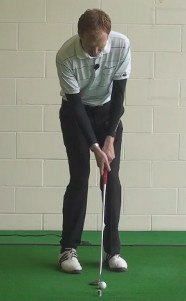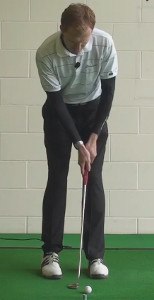
Off-the-green putting, also known as “fringe putting” or “bump-and-run,” refers to the technique of using a putter from just off the green to roll the ball towards the hole. It's a useful skill to have when you have limited green to work with or when chipping might be challenging. Here are some basics for off-the-green putting:
- Assess the situation: Evaluate the distance, slope, and the lie of the grass around the ball. Determine if the surface is relatively smooth or if there are any obstacles or inconsistencies that could affect the roll.
- Select the appropriate club: Generally, a putter is the preferred club for off-the-green putting. However, if you have a significant amount of fringe to cover or if there are obstacles to negotiate, you might consider using a hybrid club or a wedge with less loft to achieve a lower trajectory.
- Choose a target line: Identify a specific spot or a target line where you want the ball to roll. Consider the slope and the break of the green to gauge how the ball will react once it reaches the putting surface.
- Address the ball: Set up with your feet shoulder-width apart and the ball positioned slightly back in your stance. Lean slightly towards the target to promote a descending blow on the ball.
- Execute a putting stroke: Use your putting stroke technique to strike the ball. Focus on a smooth, controlled, and pendulum-like motion with minimal wrist action. Keep the stroke compact and avoid scooping or flipping the clubhead.
- Maintain a consistent tempo: Develop a rhythm and tempo that is appropriate for the distance you need to cover. Practice varying the length of your backswing to control the speed of the ball.
- Control the roll: Adjust the length of your stroke to regulate the distance the ball travels. Generally, a longer backswing generates more power and roll, while a shorter backswing produces less distance. Experiment and practice to get a feel for the roll and distance control with your putter.
- Read the green: While off-the-green putting, it's essential to read the slope, grain, and any potential breaks on the putting surface to ensure your ball rolls along the desired path. Although the ball won't be on the green yet, understanding the green's characteristics will help you make better decisions on speed and line.
- Practice and experimentation: Spend time on the practice green or at a chipping area to practice off-the-green putting. Vary your distances and lies to develop a feel for how the ball reacts with different stroke lengths and green conditions.
Off-the-green putting can be an effective way to navigate challenging situations around the green. With practice and experience, you can become more confident in your ability to execute these shots and improve your overall short game performance.
The putter can be a valuable tool for shots from off the green, but only if you know when to use it. The “how” is relatively simple.
Choosing to putt rather than chip from off the green greatly reduces the potential for a bad mishit, which is why the old axiom, “Your worst putt usually beats your best chip” still rings true. There’s no need to worry about variables, either, such as how high or far to chip the ball, where to land it, and what effect spin may have once it hits the green.
The most obvious off-the-green situation where the putter is preferred is when your ball lies on the fringe or collar, no more than a few feet from the green. The putter should be considered in other instances as well, such as closely cropped fairway or collection areas. Keep these factors in mind when choosing a club:
- If the ground is especially firm or the grass mowed extra-tight, the putter is a great option from well off the green – sometimes several yards.

- Before deciding to putt, make sure there are no obstacles in your line that could slow or re-route the ball, such as divots, sprinkler heads, patches of rough or sand that’s been blasted from a nearby bunker.
- If you’re playing into a severe grain in the grass (growing toward you), putting may cause the ball to bounce or skip and lose speed. Chipping may be a safer option.
- If you’re playing down-grain (growing in the direction of the shot), a putt will typically roll nice and true.
When putting from fringe or fairway, simply use your normal putting address and stroke. Make sure your hands remain slightly ahead of the ball; if they’re behind it you’ll add loft to the putter, causing the ball to go airborne, bounce and lose speed or veer off line.
You’ll need to hit the ball a little harder to account for the longer grass, so make several practice strokes while looking at the hole – not the ground – to get a feel for the length of stroke needed.





